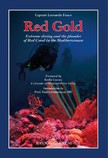
Red Gold
Extreme diving and the plunder of Red Coral in the Mediterranean
The true story of extreme deep diving with air and with rebreathers, in which Leonardo Fusco pioneers a new frontier for a centuries old maritime
tradition. As friends who also push the limits of this new fron- tier are killed, Leonardo pioneers the use of hyperba- ric and submersible technology, with assistance from his friends Hans Hass and
Gerhard Haux.
For Captain Leonardo Fusco the discovery of the sea started at the age of nine. Years later
while snorkeling off the coast of Palinuro, he discovered a branch of Corallium Rubrum (red coral) that for centuries has been widely traded and highly valued in the jewelry industry. As a result of
this discovery, he started to search for coral and soon he became the first coral- laro.
The intention of the author in writing this book is to make the nations of the world aware of
this sad reality and to promote a universal consensus for the protection of Red and Pink Coral (Corallium Rubrum) and for making trade of all coral illegal.
A portion of the proceeds from this book will go to www.Reef.org
Leonardo Fusco after being licensed as an off- shore captain in 1950, kept practicing this
dangerous and mysterious profession of corallaro (diving for red coral) for over thirty years. He then travelled to anywhere in the world where the presence of red coral was known or suspected: in
Sardinia, then Costa Azzurra, Costa Brava, Morocco and for five long years in Tunisia, and finally in Japan. He then started researching and experiment- ing in order to improve both diving safety
standards and the survival of the Corallium Rubrum species.
In 1953, at Cape Spartivento, Leonardo Fusco made his first Aqua Lung dive, and everything
changed. As spearfishing led Hans Hass to an underwater career of science, film and photo- graphy, so spearfishing led Leonardo to an under-water career of coral harvesting, marine biology, mixed gas
technology and hyperbaric research.
This book written by Leonardo Fusco is dedicated to the worldwide protection of red and pink
coral off the coast of Sardinia, the Mediterranean and throughout the world, which is in danger of extinction due to human intervention.
Leonardo Fusco, is known all over Europe and Japan as “ il Comandante” (The Captain) or the “
Master Mariner” for his astute knowledge of all things of the sea. I have known him well, as we met multiple times years ago, mostly in Italy at meetings dedicated to hyperbaric medicine: I had newly
been elected President of the Undersea and Hyperbaric Medical Society. It is an international and scholarly non- profit organization dedicated to the worldwide collection of scientific information
for diving and hyperbaric medicine. When I met Fusco in 1995, he had already completed several careers: as an underwater explorer, as a self taught diving maverick, as a business entrepreneur
providing zoological specimens to sea aquariums throughout Europe and as a collector and harvester of red coral. Finally, Leonardo Fusco coupled his empirical knowledge and experience to safely dive
to the dangerous depths where the Mediterranean red coral thrives, usually around 80 meters underwater and deeper than it is safe to reach on a simple compressed-air dive. He called this book of his
memoirs “Red Gold”, in honor of the organism and the precious stone he learned to harvest and (as he admits) to “plunder” as a young explorer. He is now trying to create ways to re-seed the coral and
re-populate this unique creature as a renewable resource of the seas.
Our first of many meetings stands out in my mind, as “ il Comandante” and his German wife,
Vera, hosted me and my Sicilian wife, Pat, at their house in Palinuro. In this sleepy coastal town south of Napoli, across a table overlooking the sea, we shared an al fresco dinner. We discussed
various underwater artifacts from several civilizations that he had observed and collected not too far from his house, in this same sea. It was a cultured discussion in English, German and Italian
and in diverse Italian dialects. We evaluated the advantages of Heliox diving, a mixture of Helium and Oxygen, and the use of the latest rebreathers apparatus. This is a very advanced technical
breathing equipment, that we had recently used during experiments at the Duke Environmental Laboratories at Duke University, in North Carolina, with the support of the US Navy Diving Unit. Fusco, to
my surprise, had already adaqpted and used this technique in the open waters of Sardinia.
Enrico Camporesi, MD Emeritus Professor of Surgery/Anestheosiology University of South
Florida College of Medicine, Tampa General Hospital.
Leonardo Fusco entered the pristine Mediterranean Sea in 1949 and was hypnotized by the
underwater beauty that he saw and by the surge of adventure that raced though his body. Lured by the challenge of exploring the Blue Cave at Palinuro he started fee diving with home-made equipment,
following the path that Austrian pioneer Professor Hans Hass had taken a decade earlier.
History records that during 1930-1940 the early pioneers of untethered “swim diving” were
mainly hunters, and developed their breath-hold endurance by chasing and spearing fish. Leonardo became one of these. Their athleticism and abilities underwater allowed them glimpses of a new world
that hardy any humans had seen. The availability of the Cousteau-Gagnan Aqua Lung in Europe during the late 1940’s and early 1950’s gave these free divers the ability to not only stay longer in their
new world, but to dive much deeper into it. Exploration could last for more than one breath. This ability to stay longer and go deeper allowed a detailed exploration of the sea bed, and in the case
of Leonardo, allowed him to create a new fisheries trade. He became, in essence, an underwater farmer of Red Coral. However, when harvesting the crop, no thought was directed at its re-cultivation or
sustainability. It was not until later is his career that these issues came to the fore and redirected his energies.
Before Leonardo entered the sea, Red Coral had been harvested for centuries from the oceans
surface by a boat dragging a dredge and net, called The Cross of Saint Andrew, across the sea floor and snagging the coral in the net. In this style of fishing, the boat crew never saw what they were
catching until they hauled the net up. It was random fishing that wrought random destruction of everything living on the sea floor, scarring it on an immense
scale.
A far more environmentally successful method of harvesting the red coral came about with the
development of the deep sea diving helmet in the mid 1800’s. Since that period a few divers equipped with the traditional copper and brass diving helmet had gathered red coral from the depths by
harvesting each branch face-to-face through the view ports of their helmets. However, their cumbersome equipment, and the air hose that attached them like a leash to the surface boat, restricted the
range of underwater harvesting to a very limited area.
Then in 1953, at Cape Spartivento, Leonardo Fusco made his first Aqua Lung dive, and
everything changed. As spearfishing led Hans Hass to an underwater career of science, film and photography, so spearfishing led Leonardo to an underwater career of coral harvesting, marine biology,
mixed gas technology and hyperbaric research. Diving to recover his lost speargun, Leonardo discovered a carpet of red coral, and his life took a whole new direction.
Using the Aqua Lung Leonardo became probably the first free-swimming underwater farmer, as he
took to the deep dark depths of the Mediterranean to harvest crops of Red Coral in locations that had never been seen by human eyes. His were to be the first. They would not be the last. More divers
quickly appeared and the underwater Red Gold Rush started. The harvesting methods developed by Leonardo and the divers who followed him were far less damaging to the surrounding marine environment as
they were able to select individual corals, but they were so effective that corals that had thrived for thousands of years were almost harvested to extinction.
But in a Gold Rush of any hue, sustainability and preservation seldom enter the equation. En
mass the Red Coral divers pushed onwards, attempting dives that were deeper and longer.
To this day, diving deeper and longer continues to be a goal for humans. During Leonardo’s
time there was only limited information available to him on the risk of decompression sickness.
Leslie Leaney, Co-Founder of Historical Diver Society, USA.
$ 25.00
Available Now at AMAZON








